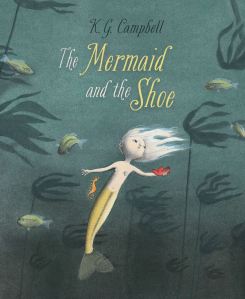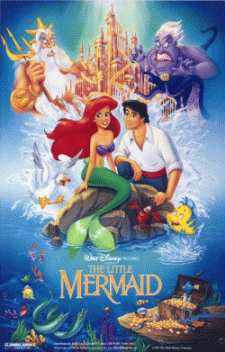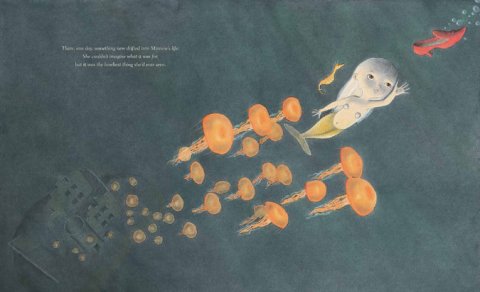“The Mermaid and the Shoe”: An Uncomplicated Fairy Tale
April 4, 2014 § Leave a comment
 K.G. Campbell’s delicately illustrated and completely charming picture book The Mermaid and the Shoe received several good reviews this week, and rightly so. The illustrations are beautiful while still engaging, and the story is simple and sweet. Minnow, the youngest daughter of a mer-king has yet to find her calling in life—her sisters tend to gardens, or train fish, but she is not good at any of these pursuits. But when she finds a strange object, she’s determined to discover its origins. Her journey takes her to the surface of the water, where she discovers a world in which mer-people don’t swim at all, but walk about on funny-looking appendages that they hide under shoes. If we were swimming in the seas of Hans Christian Andersen or Walt Disney, here would be the moment our mermaid spies her prince. But in K.G. Campbell’s refreshing book, Minnow swims quickly home, eager to tell her family all that she’s seen, and to find that her curiosity and storytelling are her calling.
K.G. Campbell’s delicately illustrated and completely charming picture book The Mermaid and the Shoe received several good reviews this week, and rightly so. The illustrations are beautiful while still engaging, and the story is simple and sweet. Minnow, the youngest daughter of a mer-king has yet to find her calling in life—her sisters tend to gardens, or train fish, but she is not good at any of these pursuits. But when she finds a strange object, she’s determined to discover its origins. Her journey takes her to the surface of the water, where she discovers a world in which mer-people don’t swim at all, but walk about on funny-looking appendages that they hide under shoes. If we were swimming in the seas of Hans Christian Andersen or Walt Disney, here would be the moment our mermaid spies her prince. But in K.G. Campbell’s refreshing book, Minnow swims quickly home, eager to tell her family all that she’s seen, and to find that her curiosity and storytelling are her calling.
The tale ends there—an uncomplicated story about a girl finding her confidence and her niche, eschewing any romance, sea-witches, or annoying foot pains. Yet the similarities between The Mermaid and the Shoe and Andersen’s The Little Mermaid (and Disney’s too, if we’re being honest here) are also what will have the adults choosing it scratching their heads. Isn’t there more? We know there is. Will this mermaid princess come to know what exists over the highest sand dune? She wouldn’t be the first — and we know from prior stories that what lies above the surface isn’t all pleasant. Parents might find this short tale easier to explain to children, but they’ll likely have trouble shaking the more complicated story that is its ancestor. And this comparison may paint The Mermaid and the Shoe in a somewhat boring light. Ah, well. It’s beautifully illustrated, and I can certainly appreciate an homage to storytelling, in any form. An endearing fable, The Mermaid and the Shoe is an escape for parents who aren’t up to explaining why any sane young mer-girl would give up her voice for a man. My hope would be that the child who has this story read to them will be inspired, as they grow, to discover more complex fairy tales.
“‘The Little Mermaid’ Molded My Idea of Love,” and Other Terrifying Inanities
February 22, 2012 § 4 Comments
This post has been in the making for two months. At first, I didn’t write it because it seemed petty—but the thing that started this long indecision, the errant article published online by someone who clearly just doesn’t know any better, has stuck with me for weeks, and I’ve figured out, finally, why.
Here’s what started it: this article, written by no one I’ve ever heard of on a site I am not familiar with: http://globalgrind.com/node/821245
Looks to be a pretty cheaply written entertainment site, somehow affiliated with TMZ and the like. The article in question is written by someone named Lindsey P, who is very upset about Julia Leigh’s new film, Sleeping Beauty, which casts Emily Browning as a sex worker who enters a drug-induced sleep every night, only to have men do what they will with her after she’s passed out. Nobody is trying to pass this off as rated G material, but Lindsey P is up in arms nonetheless:
I think it’s pretty ridiculous that there are directors out there who want to add these dark and gloomy tones to classic happy Disney movies. Do they not realize that there will be little girls and maybe even boys out there who want to see their favorite princess have the overly joyful happy ending with the handsome prince on their arm? At this point, no childhood memory is safe!
Yikes.
Lindsey P’s argument is that filmmakers should at least re-name these “twisted and gloomy” films, so that poor, naïve children won’t get fooled thinking that they’re the “classic Disney princess movies” that we all KNOW are the originals. Those crazy filmmakers! What do they think they’re doing, using Disney stories this way? Oh woe, woe is Lindsey P.
And upon my first read, I just laughed it off. (Well, laughed it off and left a comment, because we all have our weaker moments, don’t we?) This is probably some high school student, trying to write a persuasive piece for the first time, and somebody showed her how to upload it to a site, I thought. Who cares?
But as I tried to go on about my life in the following weeks, the article kept popping into my head, aggravating and infuriating me. I found myself wanting to throttle Lindsey P, to give her a good talking to. Why? I kept asking myself. So someone wrote a badly written, conservative essay and it’s online. If that gets you every time, you’ll be dead of stress before you hit 30.
But it kept coming back, and each time I realized that I was thinking about this article, I’d get angrier and angrier. Finally I had to ask myself: what is it about this article in particular, this girl’s problem with fairy tales that has your goat held so firmly by the leg?
When I went back and read over the offending piece again, I found what had stuck in my craw, so to speak. Here’s the choice tidbit:
 When I was a young girl, I looked towards fairy tales to mold my idea of love. They were what I wished for myself when it came to falling in love and learning about life… I wanted to be like Ariel, not only so I could swim and have cute fishes and a lobster as friends, but so I could meet a handsome young prince to sweep me off my feet. What girl wouldn’t want a love like that?
When I was a young girl, I looked towards fairy tales to mold my idea of love. They were what I wished for myself when it came to falling in love and learning about life… I wanted to be like Ariel, not only so I could swim and have cute fishes and a lobster as friends, but so I could meet a handsome young prince to sweep me off my feet. What girl wouldn’t want a love like that?
You guys.
She’s saying that The Little Mermaid taught her everything she wants to know about love and life.
There is no hope left for humanity. « Read the rest of this entry »
